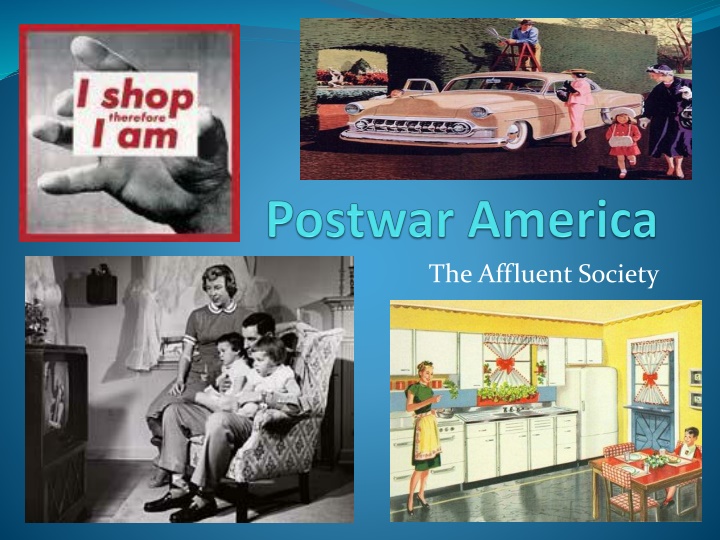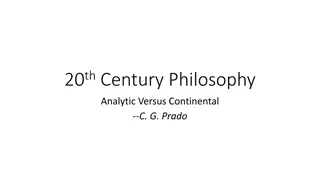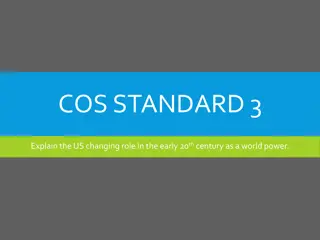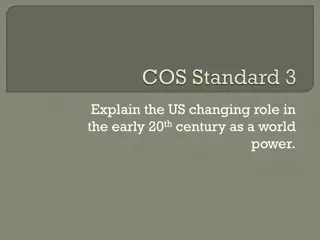The Affluent Society: Overview of American Abundance in the Mid-20th Century
In "The Affluent Society," John Kenneth Galbraith describes the rise of an economy of abundance in the United States post-World War II. The era saw a tripling of income, a shift towards white-collar jobs, the rise of multinationals and franchises, and a culture emphasizing consumerism and conformity, exemplified by the growth of suburbs like Levittown.
Download Presentation

Please find below an Image/Link to download the presentation.
The content on the website is provided AS IS for your information and personal use only. It may not be sold, licensed, or shared on other websites without obtaining consent from the author.If you encounter any issues during the download, it is possible that the publisher has removed the file from their server.
You are allowed to download the files provided on this website for personal or commercial use, subject to the condition that they are used lawfully. All files are the property of their respective owners.
The content on the website is provided AS IS for your information and personal use only. It may not be sold, licensed, or shared on other websites without obtaining consent from the author.
E N D
Presentation Transcript
American Abundance John Kenneth Galbraith (an economist) Published The Affluent Society The United States and a few other industrialized nations had created what Galbraith called an economy of abundance. New business techniques and improved technology enabled these nations to produce an abundance of goods and services for their people all of which allowed many of them to enjoy a standard of living never before thought possible.
American Abundance The Spread of Wealth Income tripled between 1940 and 1955 White Collar workers outnumbered blue collared workers for the first time White collar jobs: jobs in which a person could wear a shirt and tie (office) Blue-collar jobs: jobs where physical labor is performed (in industry)
American Abundance Multinationals and Franchises Business expanded overseas and took advantage of a cheaper labor pool to become multinational corporations Franchises: where a person owns more than one or several stores of a chain operation, became common
American Abundance The Organization Man Employees were expected to conform to the standards and norms of the organization that they worked for and to fit in without speaking out against the company In a book by William H. Whyte, Jr. called The Organization Man, the American worker was characterized as, In group doctrine the strong personality is viewed with overwhelming suspicion and the person with his own ideas is considered a threat .
American Abundance The New Consumerism People wanted to own the same new products as their neighbors ( keeping up with the Jones ) More sophisticated advertising helped spur America s spending spree
American Abundance The Growth of Suburbia Levittown: one of the earliest suburbs located in New York The suburbs were criticized for mass producing hundreds of simple and similar looking homes Some observers viewed the growth of such plain and identical looking communities as another sign of America s tendency toward conformity
The 1950s Family The Baby Boom Birthrates exploded between 1945 and 1961 More than 65 million children were born A child was born every 7 seconds during the height of the baby boom Today these baby boomers are retiring in record numbers
The 1950s Family Women in the Fifties Many women focused on being homemakers. Magazines and other media advertised that a woman would be happy by supporting her husband in the home as he went to work each day. Despite this, women working outside of the home increased during the 1950s.
Technological Breakthroughs Advances in Electronics The transistor made it possible to miniaturize radios and calculators Univac (Universal Automatic Computer) was an early model computer that handled business data and launched the computer revolution.
Technological Breakthroughs Medical Miracles Jonas Salk developed an injectable vaccine that prevented polio. Albert Sabin developed an oral vaccine for polio.
Technological Breakthroughs Conquering Space Four months after the Soviets launched Sputnik, the United States launched its first satellite into space. Airplanes became smoother and faster.
The diagram shows three board categories of factors that contributed to the baby boom. Explain these factors and how they contributed to the baby boom. Government Baby Boom War s End Popular Culture
The diagram shows three board categories of factors that contributed to the baby boom. Explain these factors and how they contributed to the baby boom. Several factors contributed to the baby boom. First, young couples who had delayed marriage during World War II and the Korean War could now marry, buy homes, and begin their families. In addition, the government encouraged the growth of families by offering generous GI benefits for home purchases. Finally, television and in magazines celebrated pregnancy, parenthood, and large families.
What were some reasons for rapid growth of suburbia in the 1950s?
What were some reasons for rapid growth of suburbia in the 1950s? Some whites moved to the suburbs to escape the crime and congestion of the city. Others viewed life in the suburbs as a move up to a better life. Also, the GI Bill offered low-interest loans, making new housing quite affordable during the post war period. Equally attractive was the government s offer of income tax deductions for home mortgage interest payments and property taxes. For millions of Americans, the suburbs came to symbolize the American dream. They owned their homes, sent their children to good schools, lived in safe communities, and were economically secure.























